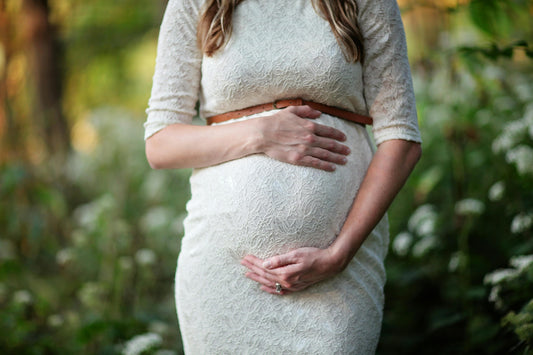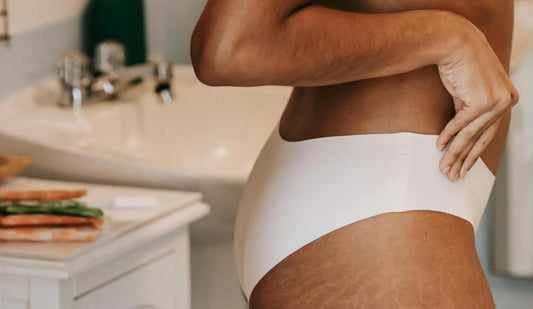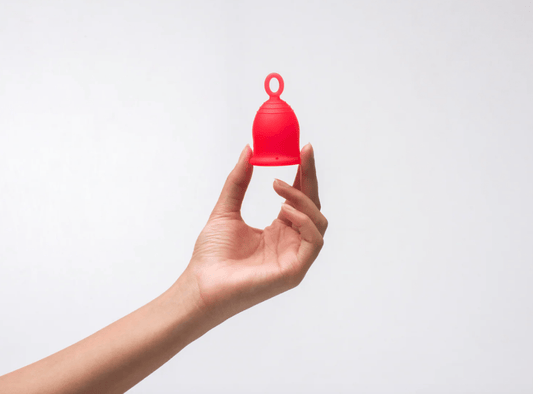 Are you sick of the itchiness, chafing and discomfort of using pads to manage your period? Do you want to make the switch to an insertable period product but don’t know where to start?
Are you sick of the itchiness, chafing and discomfort of using pads to manage your period? Do you want to make the switch to an insertable period product but don’t know where to start?
Well, look no further. This blog will tell you everything you need to know about the difference between menstrual cups and tampons - two widely used insertable period products.
While both menstrual cups and tampons are insertable and sit inside your vagina, there are many differences in the design, material, functionality and usage of these two products.
So let’s compare menstrual cups and tampons to help you decide the best period product for your body.
Learning about tampons
What are tampons?
A tampon is an insertable period product that sits in your vaginal canal and absorbs your menstrual flow during your period.
Before use, a tampon is approximately one centimetre in diameter and has a tube-like shape. It starts expanding as it soaks up your menstrual fluid inside your vagina.
What are tampons made from?
Conventional tampons are usually made from cotton or rayon, which is a fibre made from processed wood pulp. In fact, some tampons are made from a blend of both cotton and rayon.
Organic tampons, on the other hand, are made from 100% organic cotton - so no pesticides or herbicides are used in the process of growing cotton.
 How do you insert a tampon?
How do you insert a tampon?
You can insert a tampon with or without an applicator.
As a beginner, it might be good to start with an applicator - which is a plastic tube that carries the tampon inside it to make it easier to insert the tampon inside your vagina.
To insert a tampon with an applicator, you need to insert about half of the applicator carrying the tampon inside your vagina. After this, you can use your index finger or thumb to push the tampon through the applicator deeper into your vagina so it’s fully inside you. Then, just pull the applicator out.
To insert a tampon without an applicator, simply locate your vaginal entrance and gently push the tampon inside. Make sure you do this slowly as the cotton of the tampon can cause friction with your vaginal walls.
How do you remove a tampon?
A tampon is designed with a string which sits at the entrance of your vagina while the tampon is inside you. Make sure to wash your hands before you start removing your tampon.
To remove a tampon, first locate the string. Keep in mind that the string can sometimes enter your vagina and feel like it’s lost - but don’t worry! Just insert a finger and move it around until you’re able to find it.
 Once you’ve located the string, gently pull it using two fingers until your tampon starts coming out.
Once you’ve located the string, gently pull it using two fingers until your tampon starts coming out.
The easiest way to do this is by squatting over the toilet so that your legs are spread apart.
How long can you use tampons for?
You can use tampons for around 4-8 hours, depending on how heavy your period flow is.
The rule of thumb is to never keep a tampon inside you for more than 8 hours at a time as that can lead to health hazards - such as infections or toxic shock syndrome (TSS).
Can tampons be reused? Are they eco-friendly?
No, unfortunately a tampon cannot be reused as it soaks up your period flow and needs to be thrown away after use.
 What this means is that for every period, you’ll get through around 15 tampons - that’s almost 200 tampons in one year!
What this means is that for every period, you’ll get through around 15 tampons - that’s almost 200 tampons in one year!
As most tampons are packaged in plastic and are inserted using a plastic applicator, they are not an eco-friendly solution to manage your period.
Across our lifetime, we will throw away about 15,000 tampons - whose plastic will be sitting in landfills or become a choking hazard for marine life.
Learning about menstrual cups
What are menstrual cups?
A menstrual cup is a bell-shaped insertable device that collects, rather than absorbs, your period flow inside your vaginal canal.

What are menstrual cups made from?
Good quality menstrual cups are made from medical grade silicone.
The Asan cup is made from class VI medical grade silicone, which is the same material used in breast implants and heart stents. It’s the highest quality material that can be used to make menstrual cups and is super safe for you.
How do you insert a menstrual cup?
Before you insert a menstrual cup, make sure that you have sterilised the cup in hot water for 10 minutes. Read this blog to learn more about how to clean a menstrual cup.
To insert a menstrual cup, fold it into a C-fold or punch-down fold to create a smaller insertion point.
 Then you locate the entrance of your vagina and gently push the cup at a 45 degree angle towards your tailbone. Once the cup is inside you, it will open up into its original form and create a seal with your vaginal walls.
Then you locate the entrance of your vagina and gently push the cup at a 45 degree angle towards your tailbone. Once the cup is inside you, it will open up into its original form and create a seal with your vaginal walls.
The Asan cup has been engineered with a special rim and four suction holes to ensure that the cup pops open and creates a seal easily.
How do you remove a menstrual cup?
In order to remove a menstrual cup, you need to first locate the stem or ring at the base of the cup.
The Asan cup is designed with a unique removal ring to make it super easy to locate and remove your menstrual cup.
Insert your index finger into your vagina to locate the ring of the cup. Once you’ve located the ring, gently bring it down to the entrance of your vagina.
Then, pinch the base of your cup to release the suction. Once the suction is released, the cup will start slowly coming out.
Read this detailed guide on how to remove your menstrual cup to learn more.
How long can you use a menstrual cup?
Since a menstrual cup can hold up more blood than a tampon and it is made with medical grade silicone, you can keep it inside you for up to 12 hours.
So you can insert it in the morning and go about your day without having to worry about changing your pad or tampon.
Are menstrual cups eco-friendly?
As a menstrual cup is a reusable period product, it is very eco-friendly. Infact, a good quality menstrual cup will last you 10 years!
Menstrual cups last longer than tampons and avert all the waste of single-use period products - making it a very sustainable option.
What is the best menstrual cup to use?
Before switching to a menstrual cup, it's important to do your own research and understand the design and quality of your options. The best menstrual cup to use is one that is high quality and designed with a lot of thought.
The Asan cup was designed at the Harvard Innovation Lab and went through two years of user testing to come up with the perfect menstrual cup.
Which is better, a tampon or menstrual cup?
To answer the question, ‘are menstrual cups or tampons better?’ you should do your research about each brand and understand the product.
Ultimately, this depends on your personal preference.
 While tampons are quick to use and dispose of, menstrual cups are made with safer materials and reusable.
While tampons are quick to use and dispose of, menstrual cups are made with safer materials and reusable.
The best way you can decide is to try both tampons and menstrual cups, and then decide which one works best for you.
frequently asked questions
Are menstrual cups healthier than tampons?
Menstrual cups are a popular alternative to tampons and pads.
Are tampons or menstrual cups more economical?
Lets to a quick cost comparison of money spent on tampons vs money spent on menstrual cups.
Can tampons cause TSS?
TSS is commonly associated with the use of tampons. In order to get TSS, you need to have an existing cut or abrasion that can get infected with bacteria caused by keeping your tampon in for too long.
So if you decide to use tampons, make sure to change it every 8 hours to avoid the risk of getting TSS.
Can you sleep with a tampon or menstrual cup?
Yes, you can sleep with a tampon or a menstrual cup inside.
But it’s really important to keep in mind that you can only sleep with a tampon for less than 8 hours - as it needs to be changed within 8 hours to avoid any health risks.
On the other hand, you can keep a menstrual cup in for 12 hours. So you can get a night’s sleep and change your cup when you’re up.
Can you shower or swim with a tampon or menstrual cup inside?
The great thing is you can swim or take a shower with both tampons and menstrual cups inside.
As they are insertable period products, they do not need to be removed when you’re around water.
Ready to try a menstrual cup? Shop here now.






